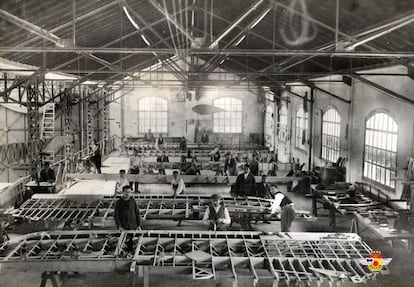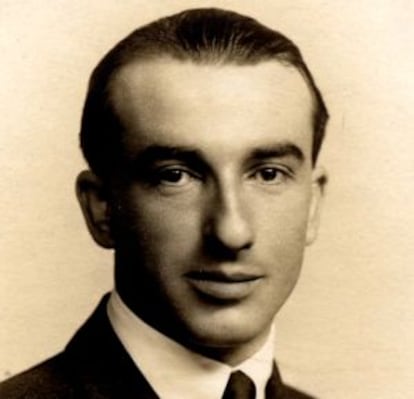A life and business spent up in the air and back down to earth
Jorge Loring founded a company that flew Zeppelins from Seville to Argentina

Jorge Loring had a dream: he wanted to fly across the Atlantic. He loved flying, and was up in the clouds as often as possible, despite the fact that at the time, just 30 years had gone by since the first working airplane had been built.
Nobody knows whether this entrepreneur from Málaga ever saw his dream come true, but he certainly got others to do so. In 1930 he opened up a new route linking Seville and Buenos Aires in just three-and-a-half days - ocean liners took 15 days - by following the line of the equator on a Zeppelin the size of the Titanic. The trade winds kept the blimp moving at speeds of up to 200 kilometers per hour.
Loring had embarked on his aeronautical adventure a few years earlier. He lived in Madrid, where he was employed as a civil works engineer, but he spent all of his free time on planes.

"He would spend the entire day drawing prototypes," recalls his daughter Mercedes, now 87. His obsession with planes led him to open a factory in Cuatro Vientos, on the outskirts of the capital, in 1923. It was called Talleres Loring (Loring workshop), and "it made him rich and ruined him around 20 times," says one of his grandchildren in a documentary about Loring's life called Huellas en el cielo (Footprints in the sky).
The factory had all the necessary permits from the Military Aviation Authority to build an airfield and open up a flying school, which became a leading training center for pilots. Four years after inaugurating the premises, in 1927, Loring and his employees created the first direct Madrid-Barcelona route, which delivered mail in record time between both cities. Commercial aviation as we know it had begun in Spain.
Even though Talleres Loring received a commission to build more than 20 Fokker C-IV aircraft, and even built the first Spanish model ever exported, the Loring R-III, its founder's career never consolidated.
"We were not bankrupt 20 times, like his grandson said, but four times definitely," says Loring's daughter Mercedes. But he always managed to pick himself up and start over again. Mercedes remembers a father figure who spent very little time at home, and who kept starting new businesses with the fortune he inherited from his father's side of the family, the Marquis of Casa Loring.
He managed to lose that fortune. All his projects ended in financial disaster, despite Loring's enthusiasm.
"He was not lucky, but he never lost hope," says Mercedes, one of Loring's eight children (seven of whom, including herself, joined religious congregations).
Franco was wary of the Loring brothers' friendly relations with Alfonso XIII
Every time he was on the brink of bankruptcy, his brother Manuel, the Count of Mieres, would make an appearance. He would pay the debts and eventually bought up all the family shares in Loring's company, constituting a new joint firm, Aeronáutica Industrial, SA (AISA).
His career ended with the Spanish Civil War (1936-1939); Franco was wary of the Loring brothers' friendly relations with Don Juan, the father of reigning King Juan Carlos I, and Alfonso XIII.
"He suggested that they take their factory to León to make planes out of wood and fabric, but they refused because they were already melting steel," explains Sonia Tercero, the co-director of the documentary together with Susan Youdelman-Azcona. Tercero believes it was precisely these political considerations that wiped Loring off the map of aviation history.
"In the historical archive of the Air Force there is hardly any mention of him," she says. "And this, considering everything he did... He was one of the founders of a company called Classa, the genesis of today's Iberia."
The Civil War also brought death to the Loring family. The airplane lover died in 1936 at age 53, assassinated by his own workers.
"It wasn't the trusted employees who worked with my father all his life, but the new ones he had hired," says Mercedes. "Their minds were poisoned with the idea of class warfare."
Eight children were left orphaned, the eldest of whom was 15. They moved to Málaga to live with their paternal grandparents. It is unknown whether Jorge Loring ever crossed the Atlantic on an aircraft, but at least he did court the love of his life, Montserrat Miró, from an airplane.
"He would get on a plane and wave to my mother as she went for a stroll along the beach," recalls Mercedes. "And that is how he wooed her."
Tu suscripción se está usando en otro dispositivo
¿Quieres añadir otro usuario a tu suscripción?
Si continúas leyendo en este dispositivo, no se podrá leer en el otro.
FlechaTu suscripción se está usando en otro dispositivo y solo puedes acceder a EL PAÍS desde un dispositivo a la vez.
Si quieres compartir tu cuenta, cambia tu suscripción a la modalidad Premium, así podrás añadir otro usuario. Cada uno accederá con su propia cuenta de email, lo que os permitirá personalizar vuestra experiencia en EL PAÍS.
¿Tienes una suscripción de empresa? Accede aquí para contratar más cuentas.
En el caso de no saber quién está usando tu cuenta, te recomendamos cambiar tu contraseña aquí.
Si decides continuar compartiendo tu cuenta, este mensaje se mostrará en tu dispositivo y en el de la otra persona que está usando tu cuenta de forma indefinida, afectando a tu experiencia de lectura. Puedes consultar aquí los términos y condiciones de la suscripción digital.









































